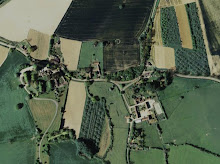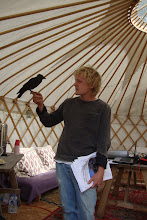
There's nothing like spending a few afternoons trespassing in orchards to clear the smoke of the city from your lungs! I have been missing-in-action doing a masters course in London, but now I'm back wandering the groves...

I had previously mentioned a mysterious dessert apple called the Orleans Reinette (or Reinette d'Orleans). Back in Cambridge, Professor John Parker, the then Director of the Botanic Gardens, had recommended this as the best apple he had ever tasted. Many others agree. Orleans Reinette was first described in 1776 and is now grown throughout Europe but it remains in Britain as something of a rarity. It has proven to be illusive to track down. With apple season fully underway, last Tuesday I tagged along to a filming event with one of the world authorities on apples in his own private orchard.

This is Barry in his orchard in Wytham in which he has collected around 130 different apple varieties. Barry is an Emeritus reader in plant sciences from Oxford University and author of 'The History of the Apple'. He is doing his thing for a Dutch film crew that are producing a series called 'Paradise' that is all about the future of food (it is the brainchild of a very interesting scientist, director and writer: Louise Fresco).

In 1929, the famous pomologist Edward Bunyard described how '...it seems to come from the Low Countries, where we first meet with it in 1776. Its brown/red flush and glowing gold do very easily suggest that if Rembrandt had painted a fruit piece he would have chosen this apple. In the rich golden flesh there is a hint of the Ribston flavour, much of the Blenheim nuttiness, and an admirable balance of acidity and sweetness which combine, in my opinion, to make the best apple grown in Western Europe....as a background for an old port it stands solitary and unapproachable.'

It's an unbelievable apple. (It stands solitary AND unnapproachable!) Really low acidity and fantastic subtle undertones of vanilla that emerge as you chew. It's also cracking with a mature (= runny) English goat's cheese a drop of Sauternes. Those slices in the background are Brownlee's Russet - notice how the Orleans Reinette does not go brown (oxidation) when its flesh is exposed to the air. Go out and find one!



Thank you for posting this. I just purchased an Orleans Reinette tree for my yard here in New York, without ever tasting one just based on its reputation. Vanilla huh? I've heard it also has the flavor of citrus tangerines and walnuts. Would you agree? I know its probably difficult, but would you be able to elaborate more on the texture of the apple possibly the flavor more? These apples are impossible to find here in the USA. Thanks!
ReplyDeleteHi Eric!
ReplyDeleteThanks for your message. Congratulations on your choice of apple - it's a really executive dessert apple. I know the tasting notes on a lot of websites mention citrus. I'll try to describe as accurately as possible my experience eating the last of this years crop that i managed to get hold of from Barrie Juniper's orchard. They benefit from keeping a few weeks because the flavour really develops. They were ready to pick around the tenth of October (in Oxfordshire, England) but straight of the tree they tasted quite fresh with a fair amount of acidity and a nice soft creamy aftertaste. After being ripened in a cool dry place for four or five weeks the flavours are really enhanced. The flesh is not powdery but the apples feel a little softer and have a less moisture. The sharpness and acidity is really reduced so that after chewing for a few seconds you experience a wonderfully subtle creeping aftertaste that is certainly walnutty, and i would say has notes of vanilla. They really go with the creamy favour of a mature goats cheese because the taste is not to sharp or juicy. You can imagine that with a more conventional dessert apple like a golden delicious or braeburn the general juiciness and sweetness might clash with a cheese more than compliment. The apples look beautifully sophisticated as well with a russety skin that has golden flushes beneath it.
I hope that is in some way informative. Do let me know how you get on with yours! If you have any photos send them across and I can include you as a Charingworth Orchard Trust trans-Atlantic connection!
All the best,
Henry
Henry,
ReplyDeleteThanks for the response, we seem to be going in 10 day cycles. Your description is very helpful. From all accounts, this apple seems to be really under appreciated. I've also read that this apple is great to cook with as the slices hold their shape and dont go soft. I dont see it grown anywhere around me, and I think that would apply to about every England/France variety. Im lucky to have tried Cox's Orange Pippin this year, one farm in the area has them, so its not like they cant be grown in this climate.
I'll get you pictures, but it will be a few years, the Orleans Reinette is coming in the spring along with another England favorite, Kidd's Orange Red. If the Orleans Reinette is anything like Calville Blanc D'Hiver, my girlfriend may win some pie contests around here.
Thanks again, I'll be in touch sometime.
-Eric
My 3 trees:
Jonamac on G30
Orleans Reinette on G202
Kidd's Orange Red on G11
Henry,
ReplyDeleteI've had the opportunity to sample this apple.
Here is my review:
http://fruitgardener.wordpress.com/2012/12/18/orleans-reinette-apple-review/
Best wishes,
-Eric